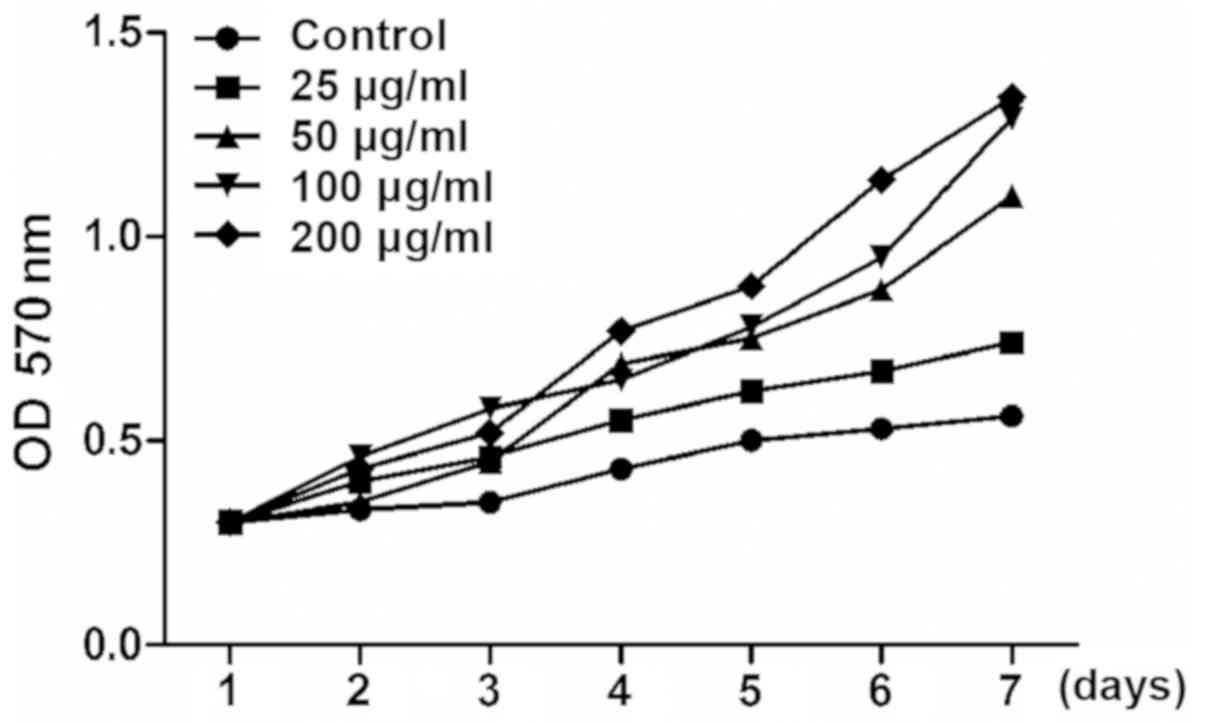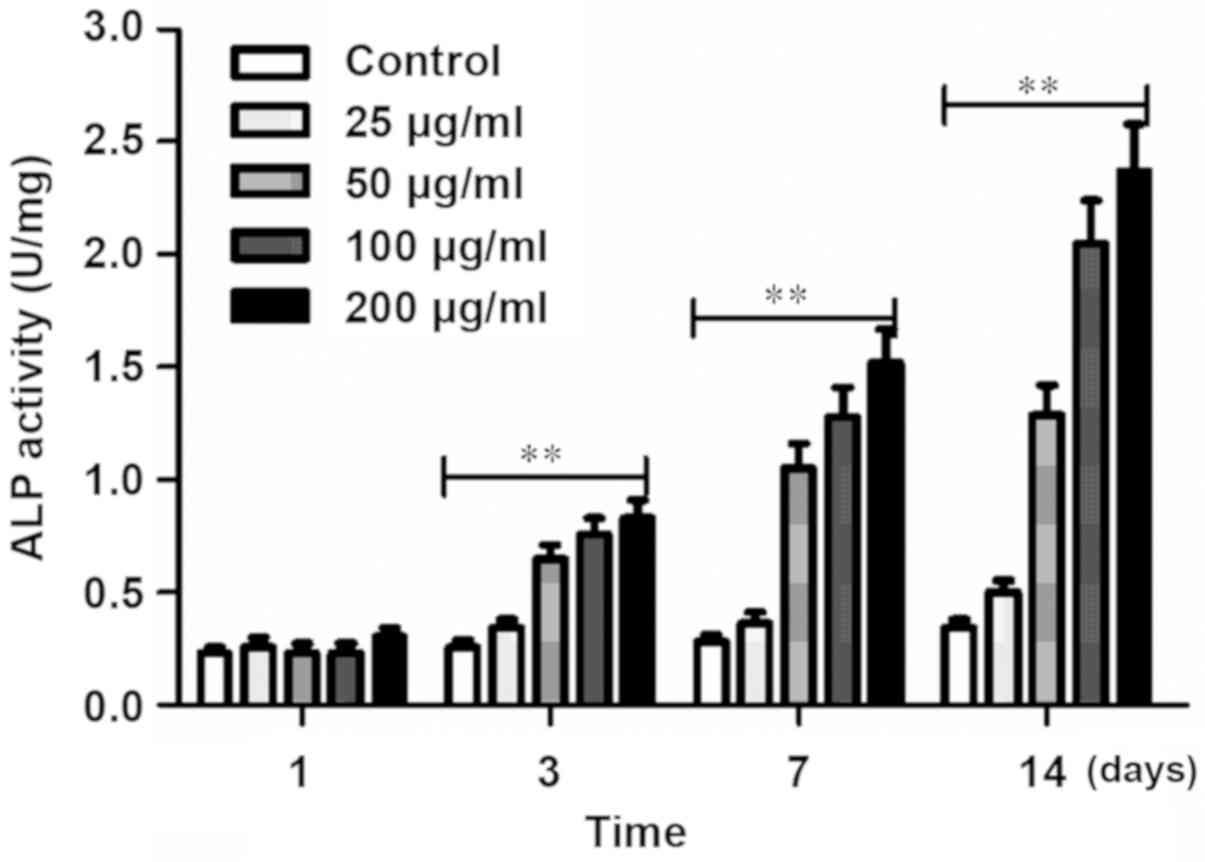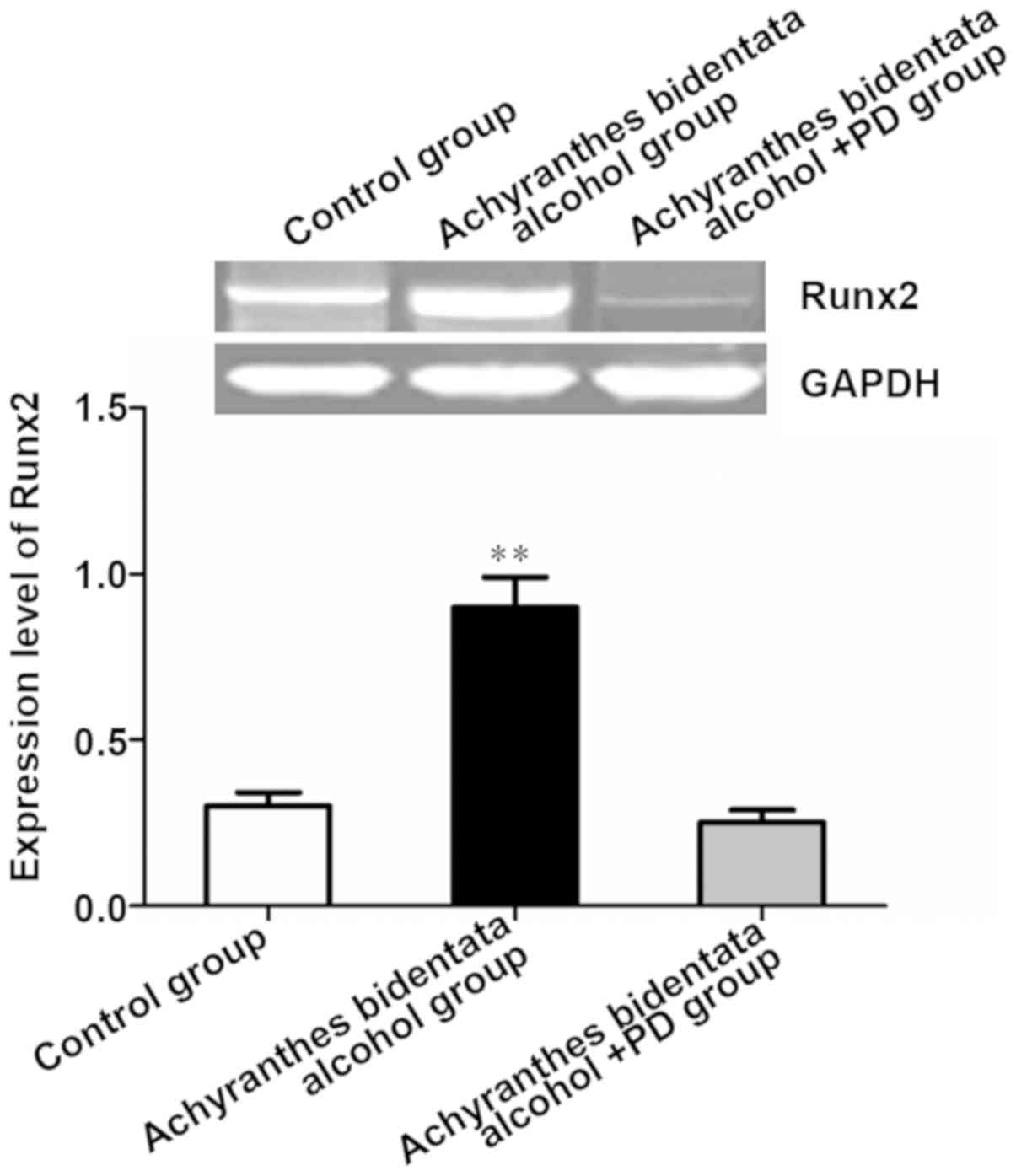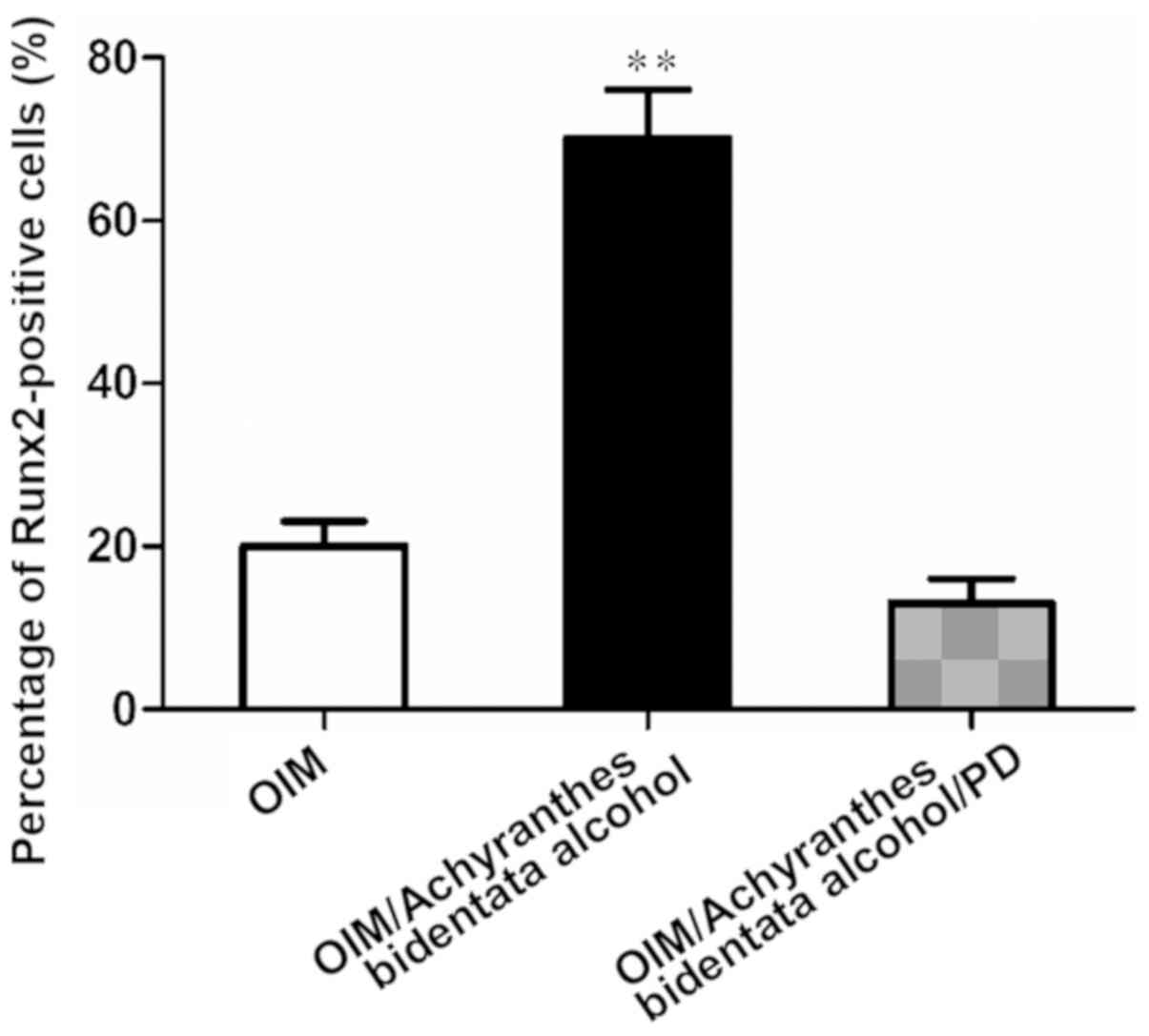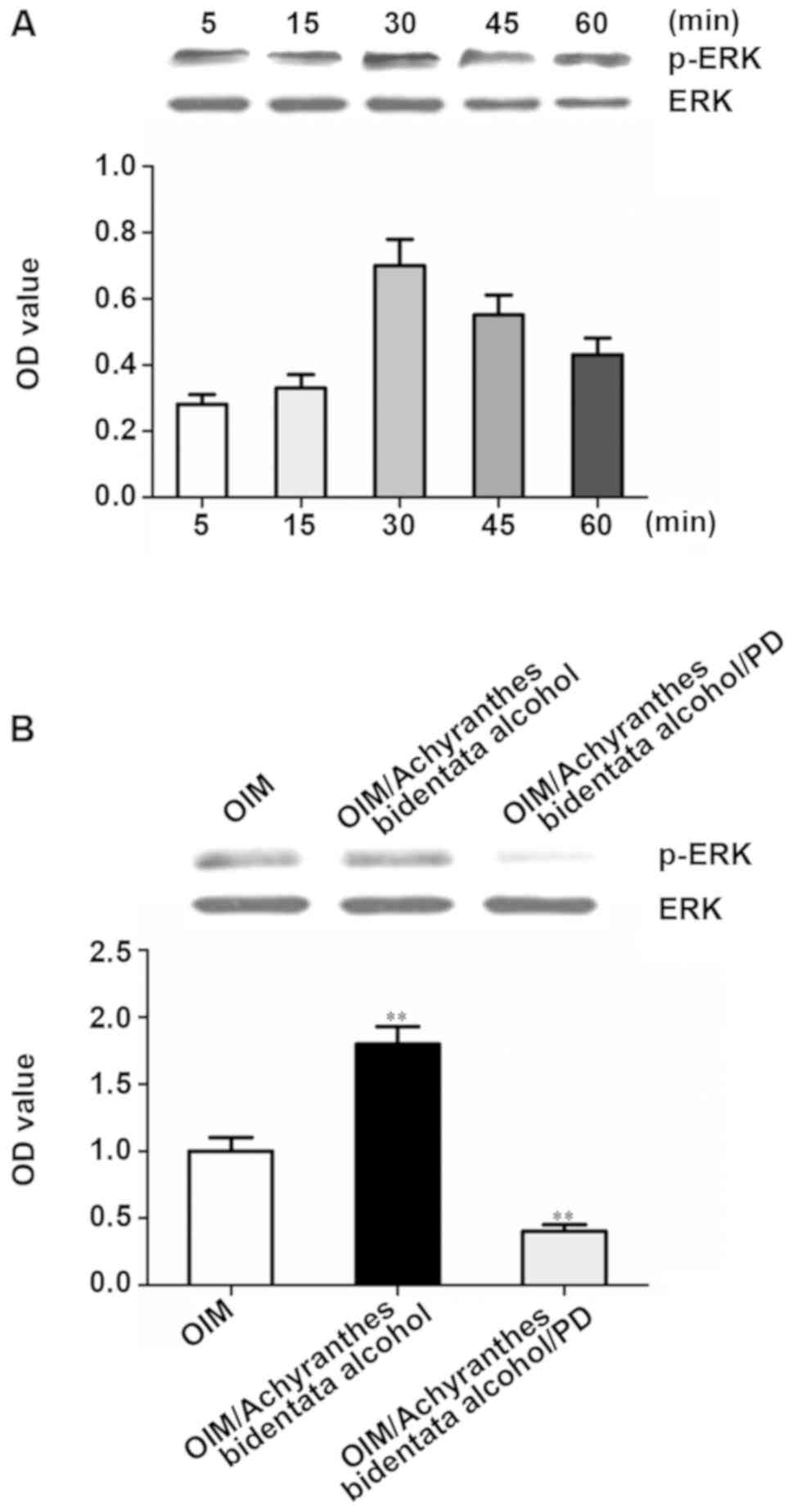Introduction
Osteoporosis is a serious health problem, and there
are no fully effective treatment methods. The loss of activity of
osteoblasts or the increase of activity of osteoclasts leads to
osteoporosis (1). However,
inhibiting the osteoclast-mediated reabsorption alone cannot reduce
the severity of bone, joint or muscle pain (2). Drugs promoting proliferation or
inducing differentiation of osteoblasts play an important role in
bone formation (3). In some studies,
agents that stimulate bone formation have been used in the
treatment of osteoporosis, such as growth hormone (4). Due to relevant side effects, however,
the expected improvement in bone mass and bone-binding rate has not
been confirmed (5). Therefore, it is
necessary to continue to search new and effective remedial measures
for bone loss in the elderly.
In history, Chinese herbal medicinal plants in folk
medicine are often used for the discovery and development of new
medicines. Achyranthes bidentata, an upright annual herb of
Amaranthaceae, is distributed in the hilly areas of China,
South Korea, Japan and India, which, in traditional and folk
medicine in these and other adjacent countries, is widely described
as having anti-inflammatory, anti-pyretic, anti-rheumatic and
diuretic activities (6). In ancient
times, in fact, Achyranthes bidentata was recommended for
prolonging the life span, and it was believed that it could
strengthen muscles and bones, improve hepatic and renal tension and
promote blood flow (7).
The pharmacological activity and active chemical
components of the whole-plant Achyranthes bidentata,
especially Achyranthes bidentata root, have been widely
studied. Its major component, Achyranthes bidentata alcohol,
possesses anti-asthmatic, anti-inflammatory, anti-pyretic,
anti-rheumatic and diuretic activity (8,9). Wattel
et al revealed that the osteoclast differentiation declines
due to quercetin (10). It is
reported that another kind of chemical substance in the plant,
ketosteroid, can prevent bone loss in ovariectomized animals
(8,9). The main bioactive component of
oleanane-type Achyranthes bidentata alcohol has been proved
to have various activities, such as anti-fertility (11,12),
antitumor (13), analgesia,
anti-inflammation and promotion of blood circulation (14). Achyranthes bidentata alcohol
can effectively prevent and treat retinoic acid-induced
osteoporosis in rats (15–17). However, the mechanism of osteogenic
effect of Achyranthes bidentata alcohol on bone mesenchymal
stem cells (BMSCs) has not been fully clarified.
Mitogen-activated protein kinase (MAPK) plays a key
role in regulating the signal transduction pathways of
embryogenesis, differentiation, proliferation and death of living
cells, in which extracellular signal-regulated kinase (ERK) has
been proved to be an important signaling molecule involved in the
differentiation of the precursor adipose cell line 3T3-L1 into
mature adipose cells (18,19). MAPK is considered to be able to
mediate the activation of several gene products involved in bone
formation, including alkaline phosphatase (ALP) and several
transcription factors, such as Runt-related transcription factor 2
(Runx2), Osx and BMB2 (20).
The transcription factor Runx2 is a major decisive
factor of osteoblast differentiation, whose expression is prior to
osteoblast differentiation. The inactivation of Runx2 prevents
osteoblast differentiation, and the haploid insufficiency of Runx2
leads to skeletal dysplasia, namely cranial dysplasia characterized
by delaying osteoblast differentiation, and leading to clavicle and
open fontanelle dysplasia. However, little is still known about
several biological aspects of Runx2. For example, the nature of
molecular events leading to the accumulation of Runx2 in
osteoblasts is unknown to a large extent. It is necessary to study
whether and how Runx2 promotes bone formation through
differentiated osteoblasts (21).
In this study, whether Achyranthes bidentata
alcohol enhances osteoblast proliferation and osteogenic effect
through activating ERK1/2 signaling pathway was investigated. The
effect of Achyranthes bidentata alcohol on the proliferation
of osteoblasts was detected via methyl thiazolyl tetrazolium (MTT)
assay. The ALP activity was measured to detect the effect of
Achyranthes bidentata alcohol on cell differentiation.
Moreover, the micro ribonucleic acid (miRNA) expression level in
the transcription factor Runx2 of the bone formation marker was
detected via reverse transcription-quantitative polymerase chain
reaction (RT-qPCR).
Materials and methods
Main experimental materials
Dexamethasone, ascorbic acid, β-sodium
glycerophosphate and inhibitor PD98059, MTT (both from
Sigma-Aldrich; Merck KGaA), microtiter plate reader (Bio-Tek
Instruments, Inc.), ALP activity assay kit (Nanjing Jiancheng
Bioengineering Institute), Bio-Rad protein assay reagent (Bio-Rad
Laboratories, Inc.), chemiluminescence detection system (Cell
Signaling Technology) and image analysis system (NIH Image, version
1.61).
Preparation of primary osteoblasts in
rats
Thirty male Sprague-Dawley rats aged 4 weeks
(100–120 g) were purchased from the Laboratory Animal Science of
Nanchang University, and placed under controlled environment in
cage [22°C, 60% humidity, 12-h light/dark cycle (from 6:00 to
18:00/from 18:00 to 6:00)] with free access to food and water.
Briefly, the femur and tibia were dissected, the end of bone was
cut off, and the bone marrow was rinsed with 2 ml ice-cold α-MEM
containing 10% (v/v) fetal bovine serum (FBS). The bone marrow was
repeatedly sucked, blown and beaten to obtain the osteoblast
suspension. Cells were counted using a hemocytometer, and
inoculated in a 25 ml cell culture flask with α-MEM containing 10%
FBS at a density of 1×106 cells/ml, followed by culture
in an incubator with 5% CO2 at 37°C. After 3 days,
non-adherent cells were washed and removed using phosphate-buffered
saline (PBS) 2–3 times, and adherent cells were further cultured in
the α-MEM until 90% cells were fused. Bone mesenchymal stem cells
(BMSCs) were cultured and amplified for further experiments.
The study was approved by the Ethics Committee of
the First Affiliated Hospital of Nanchang University (Nanchang,
China).
Cell culture and treatment
Osteoblasts were cultured in the osteogenic
induction medium (OIM) supplemented with 10% FBS, 0.1 µM
dexamethasone, 50 µM ascorbic acid and 10 mM β-sodium
glycerophosphate. The stock solution of Achyranthes
bidentata alcohol was prepared in PBS (pH 7.2–7.4), filtered
using a 0.22 µM filter, and added to the cell culture until the
final concentration was 25, 50, 100 and 200 µg/ml. The inhibitor
PD98059 at a final concentration of 25 µM was added into the medium
with Achyranthes bidentata alcohol.
MTT assay
The cell viability was detected via MTT assay at 1,
2, 3, 4, 5, 6 and 7 days after treatment with 25, 50, 100 and 200
µg/ml Achyranthes bidentata alcohol. MTT was dissolved in
the medium containing 10% FBS and filtered using the 0.2 µm filter.
The medium was replaced with MTT solution (200 µl/well) for cell
incubation at 37°C for 4 h. Purple formazan was dissoved with
dimethyl sulfoxide. At the end of incubation, the MTT solution was
removed and 150 µl 10% sodium lauryl sulfate in 0.01 M HCl was
added into each well. The absorbance was measured at 570 nm on a
plate reader using 630 nm filter membrane as a reference.
Determination of ALP activity
ALP in cells was detected at 1, 3, 7 and 14 days
after culture using the commercial kit. The cell culture medium was
discarded, cells were scraped and lysed in 10 mM Tris-HCl (pH 7.5)
containing 0.1% Triton X-100, followed by ultrasonic treatment. The
ALP activity was determined in the lysate according to the
manufacturers instructions. Absorbance of the final product in ALP
reaction was measured at 520 nm using a microtiter plate reader.
Four repeated results in each group were analyzed, the total
protein was detected using the Bradford's method, and the enzyme
activity was standardized.
RT-qPCR
The total RNA was isolated from bone marrow stromal
cells using RIPA lysis buffer (Takara), and reverse transcribed
into the first-strand complementary deoxyribonucleic acid (cDNA)
with AccessQuick™ RT-PCR kit (cat. no. A1701; Promega). Mixtures
were prepared in the PCR tube: Dntp Mixture (10 Mm) 1 µl, Oligo Dt
Primer (2.5 µM) 1 µl, RNA 5 µl, then add Rnase Free dH2O to 10 µl.
The reaction of denaturation and annealing was carried out at 65°C
for 5 min and on ice for 5 min. Then, the above denatured and
annealed reaction liquid was mixed with 5X PrimeScript TM Buffer, 4
µl; Rnase Inhibitor (40 U/µl), 0.5 µl; PrimeScript TM Rtase, 0.5
µl; Rnase Free dH2O 5 µl, a total of 20 µl, and reacted at 42°C for
30 min, then at 95°C for 5 min. Then the template DNA was used for
the TaqMan PCR (Thermo Fisher Scientific, Inc.) of Runx2.
Glyceraldehyde 3-phosphate dehydrogenase (GAPDH) was used as an
internal reference gene. After 2% agarose gel electrophoresis, the
product of RT-qPCR was developed with ethidium bromide. The optical
density (OD) was quantified using the gel image software with the
2−ΔΔCq method (22).
Primer sequences for RT-qPCR are as follows: Runx-2, forward,
5′-GCACCCAGCCCATAATAGA-3′ and reverse, 5′-TTGGAGCAAGAGAACCC-3′.
GAPDH, forward, 5′-GGCACAGTCAAGGCTGAGAATG-3′ and reverse,
5′-ATGGTGGTGAAGACGCCAGTA-3′. It was synthesized at 50°C and
amplified (40 cycles).
Western blotting
Cultures were collected at the specified time and
extracted in Tris-buffered saline (50 mM Tris-HCl, pH 7.6, 150 mM
NaCl) containing 1% Triton X-100, 1% Nonidet P-40 and 0.5 mM
phenylmethylsulfonyl fluoride at 4°C. After centrifugation at
12,000 × g and 4°C for 10 min, the protein content in the
supernatant was determined using the Bio-Rad protein assay reagent.
An equal amount of protein lysate (25 µg) was electrophoresed in
the 10% sodium dodecyl sulfate-polyacrylamide gel, followed by
membrane transfer to PVDF membrane and reaction with primary rabbit
anti-rat p-ERK, ERK monoclonal antibodies (1:300; cat. nos.
ab201015, ab184699; Abcam) and secondary goat anti-rabbit
polyclonal antibody (1:600; cat. no. ab205718). Finally, the
antigen-antibody complex was visualized using the chemiluminescence
detection system. The protein band was quantitatively analyzed
using the image analysis software (NIH).
Immunohistochemistry
The tissue was fixed with 10% formaldehyde at 20°C
for 16 h Paraffin-embedded tibial tissue sections (5 µm) were
deparaffinized in xylene and rehydrated with gradient ethanol
solution. In epitope retrieval, sections were routinely heated via
microwave for 10 min in 0.01 M citrate buffer (0.01 M sodium
citrate and 0.01 M citric acid, pH 6.0). At room temperature
(22°C), 100 µl 3% H2O2 was added to sections
to inhibit the activity of endogenous peroxidase for 10 min. Then
sections (5 µm) were sealed with 5% normal goat serum at 23°C for 1
h, and incubated with primary rabbit anti-rat Runx2 monoclonal
antibody (1:200; cat. no. 12556; Cell Signaling Technology) at 4°C
overnight. PBS was added as the negative control. Finally, sections
were washed at room temperature (22°C) and incubated with the
biotinylated goat anti-rabbit polyclonal antibody (1:400; cat no.
8885; Cell Signaling Technology) for 45 min. After sections were
washed with PBST 3 times and incubated at 23°C with SABC for 30
min, staining was performed using 100 µl pigment solution. The
brown colour glass slide was counterstained with hematoxylin for 1
min, followed by observation under an optical microscope (Olympus).
The percentage of positive region or cells in each sample was
calculated using Image-Pro Plus 5.0 software.
Statistical analysis
Continuous variables are presented as mean ±
standard error of mean (SEM), and analyzed using Student's t-test.
The proceude was repeated 6 times. All statistical analyses were
performed using GraphPad Prism 5.0 (GraphPad Software, Inc.).
P<0.05 indicates that the difference was statistically
significant.
Results
Effect of Achyranthes bidentata
alcohol on proliferation of osteoblasts
The pro-proliferative effect of Achyranthes
bidentata alcohol (25, 50, 100 and 200 µg/ml) on osteoblasts
was detected via MTT assay. Growth curves revealed that
Achyranthes bidentata alcohol increased the cell
proliferation in a dose-dependent manner (Fig. 1).
Effect of Achyranthes bidentata
alcohol on ALP activity in osteoblasts
Achyranthes bidentata alcohol increased the
ALP activity in cells in a dose-dependent manner, and the most
significant was under 200 µg/ml (Fig.
2).
Effect of Achyranthes bidentata
alcohol on the expression of osteoblast marker gene Runx2
Results of RT-qPCR showed that the expression of
Runx2 was significantly higher in Achyranthes bidentata
alcohol group and nearly 3 times that in the control group
(P<0.01). After treatment with the inhibitor PD98059, the
expression of Runx2 was decreased significantly compared with that
in the Achyranthes bidentata alcohol group (P<0.01),
indicating that Achyranthes bidentata alcohol promotes the
expression of osteoblast marker gene Runx2 (Fig. 3).
Detection of percentage of
Runx2-positive cells via immunohistochemistry
Immunohistochemical results manifested that the
percentage of Runx2-positive cells in treated tissues was obviously
higher than that in untreated tissues (P<0.01), further
confirming the osteogenic effect of Achyranthes bidentata
alcohol on osteoblasts (Fig. 4).
Achyranthes bidentata alcohol
regulated osteoblast differentiation through activating ERK
It has been proved in previous studies that ERK is
involved in regulating osteogenic differentiation in osteoblasts
(18). However, the mechanism of
Achyranthes bidentata alcohol-mediated ERK signal in
regulating osteogenic differentiation remains unclear. In this
study, following osteoblast growth and differentiation in the
presence of Achyranthes bidentata alcohol with or without
specific ERK inhibitor PD98059 (25 µM), the expression of
osteoblast marker gene in cells was analyzed. It was observed that
the ERK inhibitor significantly reduced the Runx2 gene expression
(Fig. 4).
Results of western blotting showed that
Achyranthes bidentata alcohol enhanced ERK phosphorylation
in osteoblasts grown under osteogenic induction. The ERK
phosphorylation began to decrease after 30 min and the ERK
phosphorylation in 45 and 60 min was still stronger than that in 5
min (Fig. 5A). Besides,
Achyranthes bidentata alcohol-induced ERK phosphorylation in
cells treated with PD98059 remarkably declined (Fig. 5B).
Discussion
The stimulatory effect of Achyranthes
bidentata alcohol on osteoblast differentiation has been proved
in previous studies (15,16). Although Achyranthes bidentata
alcohol is considered as a potential candidate for the treatment of
osteoporosis, the mechanism of its osteogenic effect on BMSCs has
not been fully studied yet. It was clearly demonstrated in this
study that Achyranthes bidentata alcohol promoted
osteogenesis of BMSCs and stimulated ALP. Upregulation of Runx2
mRNA transcripts indicated that they were regulated in
Achyranthes bidentata alcohol-activated osteogenesis
process. The enhanced ERK phosphorylation mediated by
Achyranthes bidentata alcohol further revealed that the
promoting effect of Achyranthes bidentata alcohol on
osteogenesis involved the regulation of ERK signaling pathway.
Some studies have already found several proteins and
transcription factors and their functions (21–24).
Runx2 is considered to play a role as a major osteogenic
transcription factor in the maturation process of osteoblasts
(23). Osx, a novel zinc finger
transcription factor, is specifically expressed in developing bones
(25).
MAPK is a member of serine/threonine kinase family,
which plays an important regulatory role in the gene transcription
signal transduction in response to changes in cellular environment
(26,27). To further describe the regulatory
mechanism of osteoblast differentiation mediated by Achyranthes
bidentata alcohol, whether ERK phosphorylation in
Achyranthes bidentata alcohol-treated cultures was affected
was studied. Results of this study clearly revealed that p-ERK was
upregulated rapidly and significantly in Achyranthes
bidentata alcohol-treated cultures. Obviously, these results
suggest that Achyranthes bidentata alcohol stimulates
osteogenic differentiation in osteoblasts through activating ERK
signal. However, whether Achyranthes bidentata
alcohol-induced osteoblast differentiation involves the regulation
of JNK and p38 has not been explored. To study the influence of JNK
and p38 specific inhibitors SP600125 and SB203580 on osteogenesis,
it is necessary to further clarify the mechanism and acting site of
Achyranthes bidentata alcohol.
In conclusion, results in this study provide direct
evidence proving that Achyranthes bidentata alcohol plays an
important role in enhancing osteoblast differentiation, and
stimulates the osteogenic differentiation of osteoblasts through
activating the ERK signal transduction pathway. From the
perspective of treatment, results in this study demonstrate that
Achyranthes bidentata alcohol is an effective material for
the prevention and treatment of osteoporosis. However, further work
is needed to fully understand the role of Achyranthes
bidentata alcohol in regulating osteogenesis.
Acknowledgements
Not applicable.
Funding
No funding was received.
Availability of data and materials
The datasets used and/or analyzed during the present
study are available from the corresponding author on reasonable
request.
Authors' contributions
SH wrote the manuscript. SH and XZ performed PCR and
western blotting. XZ was responsible for immunohistochemistry. Both
authors have read and approved the final manuscript.
Ethics approval and consent to
participate
The study was approved by the Ethics Committee of
the First Affiliated Hospital of Nanchang University (Nanchang,
China).
Patient consent for publication
Not applicable.
Competing interests
The authors declare that they have no competing
interests.
References
|
1
|
Niu Y, Li Y, Huang H, Kong X, Zhang R, Liu
L, Sun Y, Wang T and Mei Q: Asperosaponin VI, a saponin component
from Dipsacus asper wall, induces osteoblast differentiation
through bone morphogenetic protein-2/p38 and extracellular
signal-regulated kinase 1/2 pathway. Phytother Res. 25:1700–1706.
2011. View
Article : Google Scholar : PubMed/NCBI
|
|
2
|
Licata AA: Discovery, clinical
development, and therapeutic uses of bisphosphonates. Ann
Pharmacother. 39:668–677. 2005. View Article : Google Scholar : PubMed/NCBI
|
|
3
|
Zhang P, Dai KR, Yan SG, Yan WQ, Zhang C,
Chen DQ, Xu B and Xu ZW: Effects of naringin on the proliferation
and osteogenic differentiation of human bone mesenchymal stem cell.
Eur J Pharmacol. 607:1–5. 2009. View Article : Google Scholar : PubMed/NCBI
|
|
4
|
Berger I, Piecha G, Rabkin R, Kaya N,
Geldyyev A, Sun D, Chen Y, Koleganova N and Gross ML: Growth
hormone treatment prevents osteoporosis in uremic rats. Histol
Histopathol. 22:1231–1239. 2007.PubMed/NCBI
|
|
5
|
Lühe A, Künkele KP, Haiker M, Schad K,
Zihlmann C, Bauss F, Suter L and Pfister T: Preclinical evidence
for nitrogen-containing bisphosphonate inhibition of farnesyl
diphosphate (FPP) synthase in the kidney: Implications for renal
safety. Toxicol In Vitro. 22:899–909. 2008. View Article : Google Scholar : PubMed/NCBI
|
|
6
|
Deng HB, Cui DP, Jiang JM, Feng YC, Cai NS
and Li DD: Inhibiting effects of Achyranthes bidentata
polysaccharide and Lycium barbarum polysaccharide on
nonenzyme glycation in D-galactose induced mouse aging model.
Biomed Environ Sci. 16:267–275. 2003.PubMed/NCBI
|
|
7
|
Shen H, Yuan Y, Ding F, Liu J and Gu X:
The protective effects of Achyranthes bidentata polypeptides
against NMDA-induced cell apoptosis in cultured hippocampal neurons
through differential modulation of NR2A- and NR2B-containing NMDA
receptors. Brain Res Bull. 77:274–281. 2008. View Article : Google Scholar : PubMed/NCBI
|
|
8
|
Jin LQ, Zheng ZJ, Peng Y, Li WX, Chen XM
and Lu JX: Opposite effects on tumor growth depending on dose of
Achyranthes bidentata polysaccharides in C57BL/6 mice. Int
Immunopharmacol. 7:568–577. 2007. View Article : Google Scholar : PubMed/NCBI
|
|
9
|
Li JX, Hareyama T, Tezuka Y, Zhang Y,
Miyahara T and Kadota S: Five new oleanolic acid glycosides from
Achyranthes bidentata with inhibitory activity on osteoclast
formation. Planta Med. 71:673–679. 2005. View Article : Google Scholar : PubMed/NCBI
|
|
10
|
Wattel A, Kamel S, Prouillet C, Petit JP,
Lorget F, Offord E and Brazier M: Flavonoid quercetin decreases
osteoclastic differentiation induced by RANKL via a mechanism
involving NF kappa B and AP-1. J Cell Biochem. 92:285–295. 2004.
View Article : Google Scholar : PubMed/NCBI
|
|
11
|
Shibeshi W, Makonnen E, Zerihun L and
Debella A: Effect of Achyranthes aspera L. on fetal
abortion, uterine and pituitary weights, serum lipids and hormones.
Afr Health Sci. 6:108–112. 2006.PubMed/NCBI
|
|
12
|
Chen XM, Xu YJ and Tian GY:
Physical-chemical properties and structure elucidation of abPS
isolated from the root of Achyranthes bidentata. Yao Xue Xue
Bao. 40:32–35. 2005.(In Chinese). PubMed/NCBI
|
|
13
|
Han SB, Lee CW, Yoon YD, Lee JH, Kang JS,
Lee KH, Yoon WK, Lee K, Park SK and Kim HM: Prevention of arthritic
inflammation using an oriental herbal combination BDX-1 isolated
from Achyranthes bidentata and Atractylodes japonica.
Arch Pharm Res. 28:902–908. 2005. View Article : Google Scholar : PubMed/NCBI
|
|
14
|
Zhou ZD and Xia DJ: Effect of
Achyranthes bidentata polysaccharides stimulated dendritic
cells co-cultured with cytokine induced killer cells against SW480
cells. Zhongguo Zhong Yao Za Zhi. 38:1056–1060. 2013.(In Chinese).
PubMed/NCBI
|
|
15
|
Zhang M, Wang Y, Zhang Q, Wang C, Zhang D,
Wan JB and Yan C: UPLC/Q-TOF-MS-based metabolomics study of the
anti-osteoporosis effects of Achyranthes bidentata
polysaccharides in ovariectomized rats. Int J Biol Macromol.
112:433–441. 2018. View Article : Google Scholar : PubMed/NCBI
|
|
16
|
Zhang R, Hu SJ, Li C, Zhang F, Gan HQ and
Mei QB: Achyranthes bidentata root extract prevent
OVX-induced osteoporosis in rats. J Ethnopharmacol. 139:12–18.
2012. View Article : Google Scholar : PubMed/NCBI
|
|
17
|
Pearson G, Robinson F, Beers Gibson T, Xu
BE, Karandikar M, Berman K and Cobb MH: Mitogen-activated protein
(MAP) kinase pathways: Regulation and physiological functions.
Endocr Rev. 22:153–183. 2001. View Article : Google Scholar : PubMed/NCBI
|
|
18
|
Jaiswal RK, Jaiswal N, Bruder SP,
Mbalaviele G, Marshak DR and Pittenger MF: Adult human mesenchymal
stem cell differentiation to the osteogenic or adipogenic lineage
is regulated by mitogen-activated protein kinase. J Biol Chem.
275:9645–9652. 2000. View Article : Google Scholar : PubMed/NCBI
|
|
19
|
Sale EM, Atkinson PG and Sale GJ:
Requirement of MAP kinase for differentiation of fibroblasts to
adipocytes, for insulin activation of p90 S6 kinase and for insulin
or serum stimulation of DNA synthesis. EMBO J. 14:674–684. 1995.
View Article : Google Scholar : PubMed/NCBI
|
|
20
|
Alanay Y, Avaygan H, Camacho N, Utine GE,
Boduroglu K, Aktas D, Alikasifoglu M, Tuncbilek E, Orhan D, Bakar
FT, et al: Mutations in the gene encoding the RER protein FKBP65
cause autosomal-recessive osteogenesis imperfecta. Am J Hum Genet.
86:551–559. 2010. View Article : Google Scholar : PubMed/NCBI
|
|
21
|
Wei J, Shimazu J, Makinistoglu MP, Maurizi
A, Kajimura D, Zong H, Takarada T, Lezaki T, Pessin JE, Hinoi E, et
al: Glucose uptake and Runx2 synergize to orchestrate osteoblast
differentiation and bone formation. Cell. 161:1576–1591. 2015.
View Article : Google Scholar : PubMed/NCBI
|
|
22
|
Livak KJ and Schmittgen TD: Analysis of
relative gene expression data using real-time quantitative PCR and
the 2(-Delta Delta C(T)) method. Methods. 25:402–408. 2001.
View Article : Google Scholar : PubMed/NCBI
|
|
23
|
Nishio Y, Dong Y, Paris M, O'Keefe RJ,
Schwarz EM and Drissi H: Runx2-mediated regulation of the zinc
finger Osterix/Sp7 gene. Gene. 372:62–70. 2006. View Article : Google Scholar : PubMed/NCBI
|
|
24
|
Komori T, Yagi H, Nomura S, Yamaguchi A,
Sasaki K, Deguchi K, Shimizu Y, Bronson RT, Gao YH, Inada M, et al:
Targeted disruption of Cbfa1 results in a complete lack of bone
formation owing to maturational arrest of osteoblasts. Cell.
89:755–764. 1997. View Article : Google Scholar : PubMed/NCBI
|
|
25
|
Nakashima K, Zhou X, Kunkel G, Zhang Z,
Deng JM, Behringer RR and de Crombrugghe B: The novel zinc
finger-containing transcription factor osterix is required for
osteoblast differentiation and bone formation. Cell. 108:17–29.
2002. View Article : Google Scholar : PubMed/NCBI
|
|
26
|
Lee MH, Kim YJ, Kim HJ, Park HD, Kang AR,
Kyung HM, Sung JH, Wozney JM, Kim HJ and Ryoo HM: BMP-2-induced
Runx2 expression is mediated by Dlx5, and TGF-beta 1 opposes the
BMP-2-induced osteoblast differentiation by suppression of Dlx5
expression. J Biol Chem. 278:34387–34394. 2003. View Article : Google Scholar : PubMed/NCBI
|
|
27
|
Turjanski AG, Vaqué JP and Gutkind JS: MAP
kinases and the control of nuclear events. Oncogene. 26:3240–3253.
2007. View Article : Google Scholar : PubMed/NCBI
|















